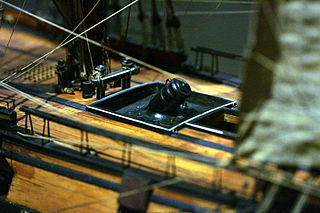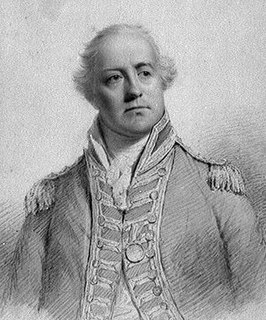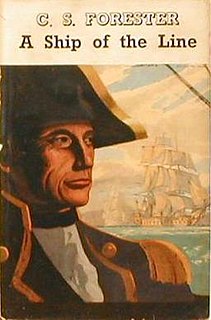
Cecil Louis Troughton Smith, known by his pen name Cecil Scott "C. S." Forester, was an English novelist known for writing tales of naval warfare, such as the 12-book Horatio Hornblower series depicting a Royal Navy officer during the Napoleonic wars. The Hornblower novels A Ship of the Line and Flying Colours were jointly awarded the James Tait Black Memorial Prize for fiction in 1938. His other works include The African Queen and The Good Shepherd.

Master and Commander is a nautical historical novel by the English author Patrick O'Brian, first published in 1969 in the US and 1970 in the UK. The book proved to be the start of the 20-novel Aubrey–Maturin series, set largely in the era of the Napoleonic Wars, on which O'Brian continued working until his death in 2000.
Horatio Hornblower is a fictional officer in the British Royal Navy during the Napoleonic Wars, the protagonist of a series of novels and stories by C. S. Forester. He later became the subject of films, radio and television programmes, and C. Northcote Parkinson elaborated a "biography" of him, The True Story of Horatio Hornblower.

Hornblower is a series of British historical fiction war television films based on three of C. S. Forester's ten novels about the fictional character Horatio Hornblower, a Royal Navy officer during the French Revolutionary and Napoleonic Wars.

A bomb vessel, bomb ship, bomb ketch, or simply bomb was a type of wooden sailing naval ship. Its primary armament was not cannons – although bomb vessels carried a few cannons for self-defence – but mortars mounted forward near the bow and elevated to a high angle, and projecting their fire in a ballistic arc. Explosive shells or carcasses were employed rather than solid shot. Bomb vessels were specialized ships designed for bombarding fixed positions on land. In the 20th century, this naval gunfire support role was carried out by the most similar purpose-built World War I- and II-era monitors, but also battleships, cruisers, and destroyers.

Admiral Edward Pellew, 1st Viscount Exmouth, GCB was a British naval officer. He fought during the American War of Independence, the French Revolutionary Wars, and the Napoleonic Wars. His younger brother Israel Pellew also pursued a naval career.

Captain Horatio Hornblower is a 1951 British naval swashbuckling war film in Technicolor from Warner Bros., produced by Gerry Mitchell, directed by Raoul Walsh, that stars Gregory Peck, Virginia Mayo, Robert Beatty and Terence Morgan.

Admiral of the Fleet James Gambier, 1st Baron Gambier, was a Royal Navy officer. After seeing action at the capture of Charleston during the American Revolutionary War, he saw action again, as captain of the third-rate HMS Defence, at the battle of the Glorious First of June in 1794, during the French Revolutionary Wars, gaining the distinction of commanding the first ship to break through the enemy line.

Sir James Lucas Yeo,, was a British naval commander who served in the War of 1812. Born in Southampton, he joined the Royal Navy at the age of 10 and saw his first action in the Adriatic Sea. He distinguished himself in combat multiple times, most notably during the Portuguese conquest of French Guiana, earning knighthoods in the Portuguese Order of Aviz and the British Order of the Bath. He was given command of the frigate Southampton, in 1812, but his ship was wrecked in the Bahamas although he was acquitted of blame for its loss. Yeo was then given command of the squadron on Lake Ontario and commanded it during several engagements with the Americans.

Mr. Midshipman Hornblower is a Horatio Hornblower novel written by C. S. Forester. Although it may be considered as the first episode in the Hornblower saga, it was written as a prequel; the first Hornblower novel, The Happy Return, was published in 1937.

Lieutenant Hornblower is a Horatio Hornblower novel written by C. S. Forester. It is the second book in the series chronologically, but the seventh by order of publication.
The Even Chance is the first of eight Hornblower television adaptations relating the exploits of Horatio Hornblower, the protagonist in a series of novels and short stories by C.S. Forester. The Even Chance is the name given to this first film in the United Kingdom, while in the United States it is known as The Duel.

Hornblower in the West Indies, or alternately Admiral Hornblower in the West Indies, is one of the novels in the series that C. S. Forester wrote about fictional Royal Navy officer Horatio Hornblower.

A Ship of the Line is an historical seafaring novel by C. S. Forester. It follows his fictional hero Horatio Hornblower during his tour as captain of a ship of the line. By internal chronology, A Ship of the Line, which follows The Happy Return, is the seventh book in the series. However, the book, published in 1938, was the second Hornblower novel completed by Forester. It is one of three Hornblower novels adapted into the 1951 British-American film Captain Horatio Hornblower R.N..

Flying Colours is a Horatio Hornblower novel by C. S. Forester, originally published 1938 as the third in the series, but now eighth by internal chronology. It describes the adventures of Hornblower and his companions escaping from imprisonment in Napoleonic France and returning to England. It is one of three Hornblower novels adapted into the 1951 British-American film Captain Horatio Hornblower R.N..
"The Last Encounter" is a short story by C. S. Forester, notable as providing the final chapter in the life of his fictional naval hero, Horatio Hornblower. It was published together with the unfinished novel Hornblower and the Crisis and another short story, "Hornblower and the Widow McCool".
Alan Lewrie is the fictional hero and main character of Dewey Lambdin's naval adventure series of novels set during the American and the French Revolutions and the Napoleonic Wars. The series spanned some twenty-five novels with a 26th reportedly in progress at the time of Mr. Lambdin's death in July 2021.
Mutiny is the fifth episode of the British film series Hornblower. It was released on April 8, 2001. It is based on the 1952 book Lieutenant Hornblower by C.S. Forester. Mutiny was written by T. R. Bowen and directed by Andrew Grieve.
The Hand of Destiny is a short story C.S. Forester wrote about his most popular character, Horatio Hornblower, written in 1940, and published in Collier's magazine. Sanford Sternlicht, author of C. S. Forester and the Hornblower Saga notes the story has multiple inconsistencies with later stories. He also notes elements of the story that Forester re-used, in later stories.













